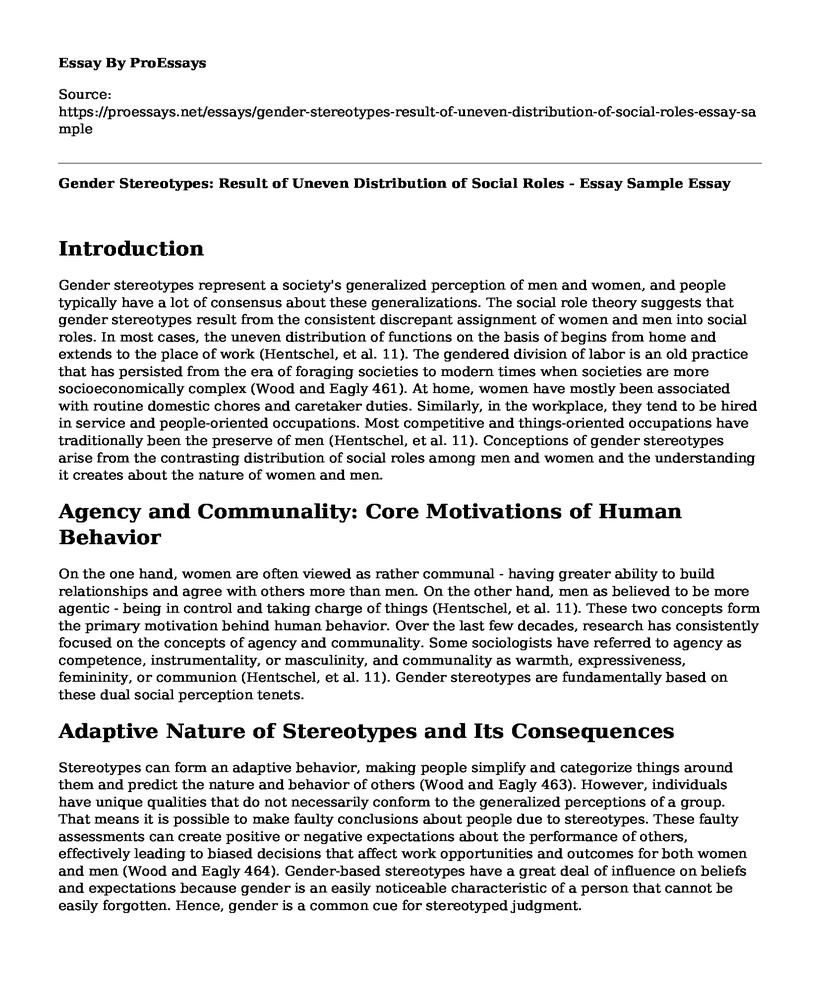Introduction
Gender stereotypes represent a society's generalized perception of men and women, and people typically have a lot of consensus about these generalizations. The social role theory suggests that gender stereotypes result from the consistent discrepant assignment of women and men into social roles. In most cases, the uneven distribution of functions on the basis of begins from home and extends to the place of work (Hentschel, et al. 11). The gendered division of labor is an old practice that has persisted from the era of foraging societies to modern times when societies are more socioeconomically complex (Wood and Eagly 461). At home, women have mostly been associated with routine domestic chores and caretaker duties. Similarly, in the workplace, they tend to be hired in service and people-oriented occupations. Most competitive and things-oriented occupations have traditionally been the preserve of men (Hentschel, et al. 11). Conceptions of gender stereotypes arise from the contrasting distribution of social roles among men and women and the understanding it creates about the nature of women and men.
Agency and Communality: Core Motivations of Human Behavior
On the one hand, women are often viewed as rather communal - having greater ability to build relationships and agree with others more than men. On the other hand, men as believed to be more agentic - being in control and taking charge of things (Hentschel, et al. 11). These two concepts form the primary motivation behind human behavior. Over the last few decades, research has consistently focused on the concepts of agency and communality. Some sociologists have referred to agency as competence, instrumentality, or masculinity, and communality as warmth, expressiveness, femininity, or communion (Hentschel, et al. 11). Gender stereotypes are fundamentally based on these dual social perception tenets.
Adaptive Nature of Stereotypes and Its Consequences
Stereotypes can form an adaptive behavior, making people simplify and categorize things around them and predict the nature and behavior of others (Wood and Eagly 463). However, individuals have unique qualities that do not necessarily conform to the generalized perceptions of a group. That means it is possible to make faulty conclusions about people due to stereotypes. These faulty assessments can create positive or negative expectations about the performance of others, effectively leading to biased decisions that affect work opportunities and outcomes for both women and men (Wood and Eagly 464). Gender-based stereotypes have a great deal of influence on beliefs and expectations because gender is an easily noticeable characteristic of a person that cannot be easily forgotten. Hence, gender is a common cue for stereotyped judgment.
Gender Stereotypes and Identity
Lastly, people do not only use gender stereotypes to characterize others; they also characterize themselves on the basis of their own stereotypes. Through self-stereotyping, people influence their identities in the direction of what they believe about the nature and social roles of men and women. As critical as gender identity is to a person's self-concept, it can include some internalized stereotyped characteristics (Wood and Eagly 470). From a young age, girls and boys acquire gender stereotypes from the media and their immediate environments and learn to put up gender-appropriate behavior.
Conclusion
In conclusion, in many societies, gender stereotypes are characterized by an image of men as more advantaged in attributes believed to be vital for success in complex tasks than women, and this view leads to gender bias in the distribution of functions both at home and at work. Gender stereotypes do not only influence people's assessment of others but also define their self-concepts. Gender stereotypes are learned through social interaction and observation. The things that children experience in their socialization have a far-reaching influence on their later lives. That explains why the differences in women's and men's self-characterizations are always consistent with the gender stereotypes in their societies.
Works Cited
Hentschel, Tanja, et al. "The Multiple Dimensions of Gender Stereotypes: A Current Look at Men's and Women's Characterizations of Others and Themselves." Frontiers in Psychology, vol. 10, 2019, p. 11.
Wood, Wendy, and Alice H. Eagly. "Two Traditions of Research on Gender Identity." Sex Roles, vol. 73, no. 11-12, 2015, pp. 461-473.
Cite this page
Gender Stereotypes: Result of Uneven Distribution of Social Roles - Essay Sample. (2023, May 22). Retrieved from https://proessays.net/essays/gender-stereotypes-result-of-uneven-distribution-of-social-roles-essay-sample
If you are the original author of this essay and no longer wish to have it published on the ProEssays website, please click below to request its removal:
- Immigration: Critical Thinking
- Essay Sample on Importance of Mitigating Terrorist Attacks
- High Rent Prices in SF Bay Area: The Cause of Unaffordable Housing - Research Paper
- Essay Sample on Domestic Violence: Underexploited Role of Police and Justice System
- Essay Sample on Black and Poor in USA: Barriers to Success
- Essay Example on Human Trafficking: An Inhuman Act
- Paper Sample on Gender Inequality: A History of Disadvantages and Recent Changes







